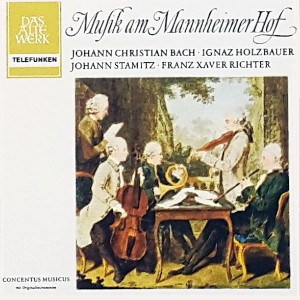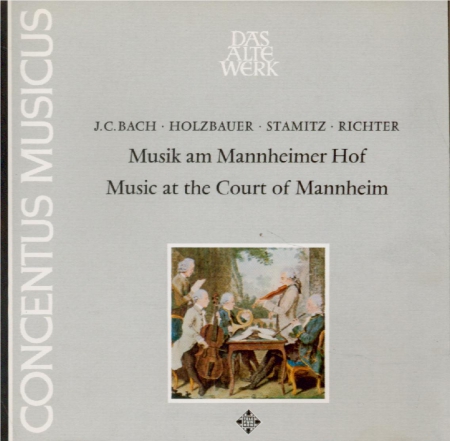 |
1 LP -
SAWT 9445-B - (p) 1963
|
 |
| 1 CD -
8.41062 XH - (c) 1989 |
|
| Musik am Mannheimer Hof |
|
|
|
|
|
|
|
| Johann Christian Bach
(1735-1782) |
|
|
|
| Quintett D-dur, op. 11 Nr. 6
- Six Quintettos for a Flute,
Hautboy, Violin, Tenor and Bass, London,
um 1776 |
|
13' 45" |
|
| - Allegro |
7' 35" |
|
A1 |
| - Andantino |
3' 21" |
|
A2 |
- Allegro assai
|
2' 55" |
|
A3 |
|
|
|
|
| Ignaz Jacob Holzbauer
(1711-1783) |
|
|
|
| Quintetto per Cembalo,
Flauto, Violino, Violetta e Violoncello
B-dur |
|
14' 15" |
|
- Allegro
|
3' 54" |
|
A4 |
- Andante
|
2' 32" |
|
A5 |
- Menuetto - Trio - Variazioi
I-V - Menuetto
|
7' 56" |
|
A6 |
|
|
|
|
| Johann Stamitz
(1717-1757) |
|
|
|
| Trio A-dur, op. 1 Nr.
2
- Six Sonates a trois parties
concertantes..., Paris, um 1761 |
|
12' 45" |
|
- Allegro assai
|
4' 56" |
|
B1 |
- Andante poco Adagio
|
3' 15" |
|
B2 |
| - Menuet |
2' 52" |
|
B3 |
| - Prestissimo |
1' 45" |
|
B4 |
|
|
|
|
| Franz Xaver Richter
(1709-1789) |
|
|
|
| Streichquartett B-dur, op. 5
Nr. 2 - Six Quatuors pour deux
Violons, alto et Violoncelle, Paris,
1768 |
|
12' 00" |
|
| - Poco
allegretto |
4' 31" |
|
B5 |
| - Poco andante |
5' 01" |
|
B6 |
| - Fugato presto |
2' 33" |
|
B7 |
|
|
|
|
| Concentus
musicus Wien (mit Originalinstrumenten) / Nikolaus
Harnoncourt, Leitung |
|
| -
Alice Harnoncourt, Eva Braun,
Barockvioline |
|
| -
Kurt Theiner, Barockviola |
|
| -
Nikolaus Harnoncourt, Barockcello |
|
-
Leopold Stastny, Traversière
|
|
| -
Jürg Schaeftlein, Barockoboe |
|
| -
Georg Fischer, Cembalo |
|
|
Luogo e data
di registrazione
|
| Opera Studio, Vienna (Austria)
- maggio 1963 |
|
Registrazione
live / studio
|
| studio |
Producer / Engineer
|
Wolf Erichson
|
Prima Edizione
CD
|
Teldec "Harnoncourt Edition" -
8.41062 XH - (1 cd) - 53' 45" - (c) 1989
- ADD
|
Prima
Edizione LP
|
Telefunken "Das Alte Werk" -
SAWT 9445-B - (1 lp) - 53' 45" - (p)
1963
|
|
|
Notes on the
program
|
Nowhere
is the epoch-making
transformation of muusical
taste around the mlddle of
the 18th century more
clearly shown than in the
German-Austrian chamber
music of the period between
1760 and 1780, and nowhere
is the significance of the
Mannheim School more evident
in the development of the
new musical idiom than in
the chamber music of that
time. The virtuosity of the
worldfamaus Mannheim Court
Orchestra enabled the
composers who played in it -
most of whom had come from
Bohemia - to experiment
without restraint with
forms, techniques of
composition and
instrumentations;
furthermore, the
understanding and the
open-mindedness of their
courtly and professional
musical audiences made
cansrderation for musical
conventions superfluous to
such a degree that the new
style was able to attain a
full flowering within the
very shortest time.
Thus
there arose a repertoire of
chamber music almost too
large to survey and
exceedingly rich in forms,
which to a very great extent
prepared the way to the
chamber music of the
Viennese classics. Indeed,
in the best works
Particularly of the three
greatest "Mannheimers",
Stamitz, Richter and
Holzbauer, the contemporary
works of Haydn were at least
equalled and, in originality
of structure and intensity
of expression, not
infrequently even surpassed.
The
writing of Johann Christian
Bach, the youngest son of
the great Leipzig cantor,
stood apart from this
mainstream of development,
although not uninfluenced by
it. The six Harpsichord
Quintets, the main chamber
music work of the "English
Bach", who worked in London
as Music Master to the Queen
from 1762 onward and enjoyed
world fame mainly as an
operatic composer and
symphonist, is dedicated to
the Elector Karl Theodor of
the Palatinate in Mannheim.
It is, however, far removed
from the typical "Mannheim
taste". Bach, the man of the
world and the court, quite
lacks the freshness and
vitality and also the
carefree joy in
experimenting of the
Bohemian Mannheimers;
instead he arrives in these
mature quintets in
particular at a synthesis of
delicate feeling and refined
taste, the highest
craftsmanlike precision and
effortless invention,
aristocratic restraint and
inspired expression, which
is unique for its age and,
not least, made a powerful
and permanent impression on
Mozart. The D major Quintet
with its "singing" Allegro,
its tender, Siciliano-like
Andantino and its gay,
playful Rondeau is a perfect
example of this exceedingly
fine, occasionally overfine,
art.
In
spite of the very similar
instrumental combination,
Holzbauer's Quintet,
probably written between
176O and 1770, is
fundamentally different in
style to J. C. Bach's. Just
as his harpsichord style
still preserves features of
continuo practice, the
extremely dense part
writing, rich in imitation,
also clearly displays
elements of the baroque
tradition. Entirely
"Mannheim", however, are the
wealth af musical contrasts
within the smallest possible
space, the chromatic
"sighing" melody - already
almost a mannerism - and the
powerful tone of the first
movement and the tender
elegiac character of the
second, while the peculiarly
broken tone to the Minuet
with its skillful variations
already
sounds almost "Mozartian".
What
Holzbauer's work lacks in
vitality is displayed in the
Trio by Stamitz - the true
leader of the Mannheim
School - in overwhelming
abundance. Stamitz's Op. 1
is an epoch-making work such
as is rarely found in the
history of music. For the
first time there appears in
it three-part writing
liberated from all the
fetters of the continuo
style. For the first time
the living melody rules
unchallenged in spite of all
the well-worked
part-writing. For the first
time the new style, with its
broad, symphonic forms, its
heaping up of contrasts in
the smallest possible space
and its overwhelming
vitality, is presented in
its finished state to a
public which - only too
understandably - was almost
bewitched by the new tone,
by the "melodia germanica",
which here broke forth like
a great phenomenon of
nature. The Trio in A major,
with its impetuous and yet
"cantabile" first movement
its Andante full of feeling
and its turbulent Finale,
gives expression to this
tone in its purest state.
Richter's
Op. 5 adheres far more
strongly to tradition, and
is less direct in its impact
yet it is more elaborate,
more differentiated and more
profound. The four-part
writing for strings, freed
from the continuo, is given
greater cohesion and
profundity by rich
contrapuntal work.
Independently of Haydn's
roughly simultaneous
development, it attains an
approximately equal sharing
of the thematic material
between all the instruments
and also the solo style of
writing of the genuine
classical quartet movement
which can no longer be
played alternatively by an
orchestra. ln this Quartet
in D flat major, the
serious, elegiac mood that
basically pervades all
Richter's works can be heard
clearly, Its extremely
rich-textured and finely
organized first movement its
wonderfully intense Andante
full of harmonic movement
and sorrowful melodiousness
and its fugal Finale, that
combines "learned"
part-writing and "popular"
motifs in an already quite
Mozartian manner, make it
one of the most outstanding
chamber music works of the
whole epoch.
|
|
Instrumentarium
|
|
-
Querflöte (Traversière): A.
Grenser, Dresden, Mitte des
18, Jh.
- Oboe: P. Paulhahn,
Deutschland, um 1720
- Violinen: Jacobus Stainer,
Absam, 1658 und 1677
- Viola: J. Leidolff, Wien, 18
Jh.
- Violoncello: Antony Posch,
Wien 1724
- Cembalo:
Kopie eines
italienischen
Kielflügels um
1700 von M.
Skowroneck,
Bremen
- Bögen: 18.
Jahrhundert
|
|
Nikolaus
Harnoncourt (1929-2016)
|

|

|
|